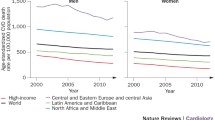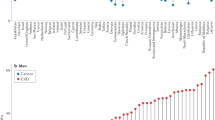Abstract
Cardiovascular (CVD) disease morbidity and mortality are changing over the years, following changes in socioeconomic conditions and underlying risk factors. However, the trends of these changes differ among various populations. There is little data regarding these trends in low CVD risk populations. Tables of deaths by cause and age for the period 1956–2007 and tables of hospitalizations for the period 1979–2003 published by the National Statistical Service of Greece were used. Trends over time were determined using log-linear regression models. Age-adjusted all-cause mortality has declined steadily since 1964 in both sexes. CVD mortality initially increased until the late 1980s and subsequently decreased. An increase in mortality from stroke was seen until 1978, especially in men, followed by a decline. Mortality from coronary heart disease (CHD) increased initially, continued to increase for one decade more than stroke and started to decrease in 1989. However, only in women has CHD mortality returned below 1956 levels. As a result, deaths from CHD have surpassed those from stroke. Although the in-hospital fatality of acute myocardial infarction (AMI) has decreased by half between 1979 and 2003, deaths from AMI have decreased only slightly, as hospitalization and morbidity rates have increased during the same period. Although the various types of CVD share common risk factors, the trends of their respective mortality rates have differed significantly over the past five decades in the Greek population. This could partly be explained by the fact that risk factors do not equally contribute to CHD and stroke, and they might have not all been equally well controlled.






Similar content being viewed by others
Abbreviations
- AMI:
-
Acute myocardial infarction
- BΜΙ:
-
Body mass index
- CHD:
-
Coronary heart disease
- CVD:
-
Cardiovascular disease
- EAPC:
-
Estimated annual percentage change
- ICD:
-
International classification of diseases
- US:
-
United States
References
Kesteloot H, Sans S, Kromhout D. Dynamics of cardiovascular and all-cause mortality in Western and Eastern Europe between 1970 and 2000. Eur Heart J. 2006;27:107–13.
Sans S, Kesteloot H, Kromhout D. The burden of cardiovascular diseases mortality in Europe. Task force of the European society of cardiology on cardiovascular mortality and morbidity statistics in Europe. Eur Heart J. 1997;18:1231–48.
Uemura K, Pisa Z. Trends in cardiovascular disease mortality in industrialized countries since 1950. World Health Stat Q. 1988;41:155–78.
Poulter N. The coronary heart disease epidemic: British and international trends. In: Poulter N, Sever P, Thom S, editors. Cardiovascular disease. Risk factors and intervention. Oxford: Radcliffe Medical Press; 1993. p. 1–11.
Keys A, et al. Epidemiological studies related to coronary heart disease: characteristics of men aged 40–59 in seven countries. Acta Med Scand Suppl. 1966;460:1–392.
Keys A. Coronary heart disease in seven countries. XV. Prognosis of coronary heart disease found at entry. Circulation. 1970;4(Supp I):I-148–53.
Menotti A, et al. Twenty-five-year prediction of stroke deaths in the seven countries study: the role of blood pressure and its changes. Stroke. 1996;27:381–7.
WHO. Prevention in childhood and youth of adult cardiovascular disease: time for action. Geneva: WHO; 1990. p. 1–105. Technical report series no 92.
Chimonas ET. The treatment of coronary heart disease: an update. Part 2: mortality trends and main causes of death in the Greek population. Curr Med Res Opin. 2001;17:27–33.
Levi F, et al. Trends in mortality from cardiovascular and cerebrovascular diseases in Europe and other areas of the world. Heart. 2002;88:119–24.
Kim HJ, et al. Permutation tests for joinpoint regression with applications to cancer rates. Stat Med. 2000;19:335–51.
Kesteloot H. Nutrition and health. Eur Heart J. 1992;13:120–8.
Papaevangelou G, Tsimpos K. Study of evolution of cardiovascular disease mortality in Greece. Arch Hellenic Med. 1984;1:476–82. (in Greek).
Moulopoulos SD, et al. Coronary heart disease risk factors in a random sample of Athenian adults. The Athens study. Am J Epidemiol. 1987;126:882–92.
Ferro-Luzzi A, James WP, Kafatos A. The high-fat Greek diet: a recipe for all? Eur J Clin Nutr. 2002;56:796–809.
Verschuren WM, et al. Serum total cholesterol and long-term coronary heart disease mortality in different cultures. Twenty-five-year follow-up of the seven countries study. Jama. 1995;274:131–6.
Menotti A, Puddu PE, Lanti M. Comparison of the Framingham risk function-based coronary chart with risk function from an Italian population study. Eur Heart J. 2000;21:365–70.
Collins R, et al. Blood pressure, stroke, and coronary heart disease. Part 2, short-term reductions in blood pressure: overview of randomised drug trials in their epidemiological context. Lancet. 1990;335:827–38.
MacMahon S, et al. Blood pressure, stroke, and coronary heart disease. Part 1, prolonged differences in blood pressure: prospective observational studies corrected for the regression dilution bias. Lancet. 1990;335:765–74.
Kearney PM, et al. Worldwide prevalence of hypertension: a systematic review. J Hypertens. 2004;22:11–9.
Stamler J, et al. INTERSALT study findings. Public health and medical care implications. Hypertension. 1989;14:570–7.
Karppanen H, Mervaala E. Sodium intake and hypertension. Prog Cardiovasc Dis. 2006;49:59–75.
Psaltopoulou T, et al. Prevalence, awareness, treatment and control of hypertension in a general population sample of 26, 913 adults in the Greek EPIC study. Int J Epidemiol. 2004;33:1345–52.
Wolf-Maier K, et al. Hypertension treatment and control in five European countries, Canada, and the United States. Hypertension. 2004;43:10–7.
Thom TJ, Epstein FH. Heart disease, cancer, and stroke mortality trends and their interrelations. An international perspective. Circulation. 1994;90:574–82.
Kromhout D, et al. Food consumption patterns in the 1960s in seven countries. Am J Clin Nutr. 1989;49:889–94.
Trichopoulou AD, Efstathiadis PP. Changes of nutrition patterns and health indicators at the population level in Greece. Am J Clin Nutr. 1989;49:1042–7.
Food and Agriculture Organization. Standardized food balance sheets. 1961–2001 [cited; Available from: www.fao.org].
van de Vijver LP, et al. Association between trans fatty acid intake and cardiovascular risk factors in Europe: the TRANSFAIR study. Eur J Clin Nutr. 2000;54:126–35.
Papadimitriou A, et al. The secular trend of body weight of Greek schoolchildren in the 20th century. Med Sci Monit. 2007;13:RA8–11.
Kapantais E, et al. First national epidemiological survey on the prevalence of obesity and abdominal fat distribution in Greek adults. Ann Nutr Metab. 2006;50:330–8.
Panagiotakos DB, et al. Epidemiology of overweight and obesity in a Greek adult population: the ATTICA Study. Obes Res. 2004;12:1914–20.
International Obesity Task Force & European Association for the study of obesity position paper. Obesity in Europe: The case for action. 2002 [cited; Available from: www.iotf.org/media/euobesity.pdf.
Kritsikis A, Vyssoulis G, Psarros T. Prevalence of coronary heart disease, arterial hypertension and distribution of risk factors in representative groups of Athens area. Arch Med Soc. 1981;7:451–6. (in Greek, abstract in English).
Lindholm LH, et al. Risk factors for ischaemic heart disease in a Greek population. A cross-sectional study of men and women living in the village of Spili in Crete. Eur Heart J. 1992;13:291–8.
Christakis G, et al. Crete: a study in the metabolic epidemiology of coronary heart disease. Am J Cardiol. 1965;15:320–32.
Panagiotakos DB, et al. Status and management of blood lipids in Greek adults and their relation to socio-demographic, lifestyle and dietary factors: the ATTICA study. Blood lipids distribution in Greece. Atherosclerosis. 2004;173:353–61.
Johnson CL, et al. Declining serum total cholesterol levels among US adults. The national health and nutrition examination surveys. Jama. 1993;269:3002–8.
Katsilambros N, et al. Evidence for an increase in the prevalence of known diabetes in a sample of an urban population in Greece. Diabet Med. 1993;10:87–90.
Athyros VG, et al. Awareness, treatment and control of the metabolic syndrome and its components: a multicentre Greek study. Hellenic J Cardiol. 2005;46:380–6.
Michaels D, Zoloth SR. Mortality among urban bus drivers. Int J Epidemiol. 1991;20:399–404.
Lakka TA, et al. Relation of leisure-time physical activity and cardiorespiratory fitness to the risk of acute myocardial infarction. N Engl J Med. 1994;330:1549–54.
Skoumas J, et al. Physical activity, high density lipoprotein cholesterol and other lipids levels, in men and women from the ATTICA study. Lipids Health Dis. 2003;2:3.
Panagiotakos DB, et al. Socio-economic status in relation to risk factors associated with cardiovascular disease, in healthy individuals from the ATTICA study. Eur J Cardiovasc Prev Rehabil. 2005;12:68–74.
EUROASPIRE II Study Group. Lifestyle and risk factor management and use of drug therapies in coronary patients from 15 countries; principal results from EUROASPIRE II Euro heart survey programme. Eur Heart J. 2001; 22: 554–72.
Lloyd-Jones DM, et al. Accuracy of death certificates for coding coronary heart disease as the cause of death. Ann Intern Med. 1998;129:1020–6.
Tunstall-Pedoe H, et al. Contribution of trends in survival and coronary-event rates to changes in coronary heart disease mortality: 10-year results from 37 WHO MONICA project populations. Monitoring trends and determinants in cardiovascular disease. Lancet. 1999;353:1547–57.
Conflict of interest statement
None.
Author information
Authors and Affiliations
Corresponding author
Rights and permissions
About this article
Cite this article
Chimonas, T., Fanouraki, I., Liberopoulos, E.N. et al. Diverging trends in cardiovascular morbidity and mortality in a low risk population. Eur J Epidemiol 24, 415–423 (2009). https://doi.org/10.1007/s10654-009-9362-7
Received:
Accepted:
Published:
Issue Date:
DOI: https://doi.org/10.1007/s10654-009-9362-7




